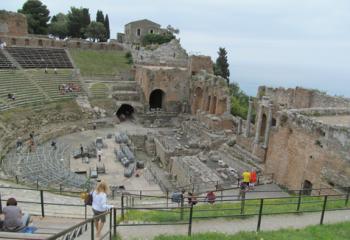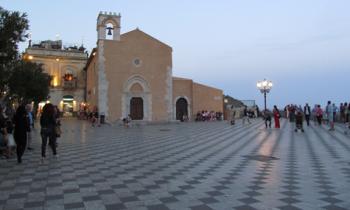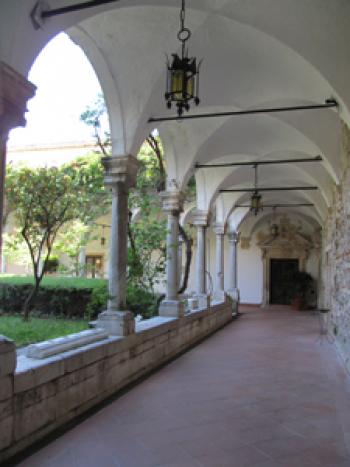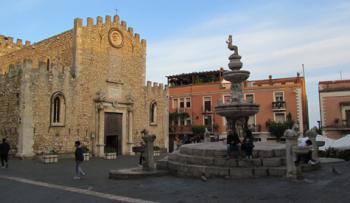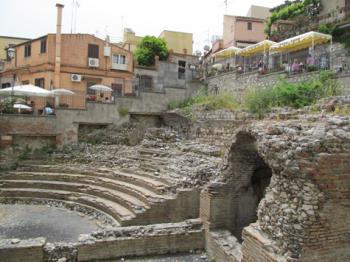In the shadow of Mount Etna
This item appears on page 55 of the March 2017 issue.
In the shadow of Mount Etna
A few of my favorite trips to Italy have been not to the great cultural and tourist centers of Rome, Venice or Florence but to some of the small hill towns found all over Italy. Over the years, my husband, Paul, and I have compiled a list of our favorites: Volterra and Fiesole in Tuscany; Erice and Ragusa in Sicily; Todi and Gubbio in Umbria, and Positano and Ravello on the Amalfi Coast south of Naples.
On a 5-week trip to Palermo, Sicily, in April-May 2016, we returned to one of the best, Taormina, which we had last seen 25 years before. We were a bit apprehensive. We had fallen in love with Taormina on that long-ago trip. Would we still love it? Would we even recognize it?
Taormina is a small town (pop., 11,000) perched high above the Mediterranean on the eastern coast of Sicily. It has the reputation of being Sicily’s classiest resort, with all the pros (great restaurants and hotels plus upscale shops) and all the cons (crowds, high prices) that fame brings.
It is also the home of a superb Greco-Roman theater as well as an equally superb hotel, the San Domenico Palace Hotel. We wanted to revisit the theater and spend a few nights in the hotel.
Rich history
The Greeks arrived in Sicily about 2,800 years ago. One of their colonies, founded around 735 BC, was Naxos, named after the Greek Cycladic island from which some of the migrants probably came.
Around 400 BC, Dionysius the Elder, tyrant of Siracusa (which was another Greek colony), ousted the Naxians but also enslaved a number of them. Those not enslaved settled on Mount Tauro, naming their new home Tauromenion.
The subsequent history of this settlement is as rich and varied as the history of the rest of Sicily. (See my articles on Norman Palermo in the January and February 2017 issues.) Tauromenion allied itself with Rome; became the capital of Byzantine Sicily; was conquered by the Arabs, and, in 1079, was taken by the Norman Count Roger, who ousted the Arabs.
After Norman rule ended in 1194, there followed a long line of Germans, Angevins, Aragonese, Spanish, Austrians, Bourbons and British — among others — marching across Sicily. In 1860, Garibaldi arrived and Italian unification began.
The greatest monument remaining from this long and complicated past is the Greek Theatre, located at the eastern edge of Taormina.
Greek Theatre
It’s called the Greek Theatre but, more accurately, should be called the Greco-Roman Theatre. Carved out of the bedrock of Mt. Tauro by Greeks in the third century BC, it was substantially enlarged and remodeled by the Romans in the early second century AD.
Visitors have to look carefully to see what’s left from the Greek period. Only the stonework beneath the skene, the structure at the back of the stage, and some of the stone seats in the cavea, the semicircular tiers of seats for spectators, still remain.
What the Romans left is much more evident, surrounding visitors on all sides. Most obviously, there’s the skene, in front of which actors performed. Much of it is still intact — columns, openings and niches — framing a magnificent view of Taormina, the bay and snowcapped Mt. Etna.
The orchestra occupied the area between the skene and the cavea. This was where musicians, dancers and the chorus performed. In front of this was the cavea. The Romans removed the lower seats of the cavea to create a larger space for the gladiatorial contests they favored, although even then there was still room to seat more than 5,000 spectators.
With the exception of the theater of Siracusa, 71 miles south of Taormina, this is the largest ancient theater not only in Sicily but in Italy. It is still used today, more than 2,200 years after it was built, for the annual TaorminaFilmFest held in June and for the annual Summer Festival of music, theater and ballet held in July.
The Greek Theatre is open 9 a.m. to 7 p.m. from April to September and from 9 to 4, October through March. Admission costs €10 (about $10.50).
Buildings from other eras
A 10-minute walk along a street lined with souvenir shops led Paul and me to the Piazza Vittoria Emanuele II, where the Roman Forum once stood.
Three noteworthy buildings are located there. One is the Palazzo Corvaja, incorporating 700 years of architectural history and including a 9th/10th-century Arab defense tower, the Norman-era Sala del Parlamento (now the tourism office), a 13th-century left wing and a 15th-century right wing.
Across the piazza is the 17th-century church of Santa Caterina and, behind the church, the ruins of the Odeon, dating probably from the late first century BC and once used for musical and literary performances.
The Odeon is small, capable of seating just a few hundred spectators in a cavea carved out of the natural slope of a hill. Looming above is a trattoria with a great view of the piazza and the Odeon.
A stroll through town
Walking along traffic-free Corso Umberto I, visitors stroll past medieval buildings and palazzi now housing mostly upscale shops selling clothing, local food products and brightly painted ceramics.
Narrow alleyways lead off the Corso to more shops and to restaurants, many with views over Taormina or the bay far below.
Along the route, you pass through Piazza IX Aprile, enclosed on three sides by 15th-century Sant’Agostino, 17th-century San Giuseppe and the 11th/12th-century Torre dell’Orologio, a tower resting on 6th-century foundations. Locals call this piazza “the balcony of Taormina” for its panoramic view over the sea.
Beyond the tower is a medieval street that leads to the Piazza Duomo, dominated by the battlemented 13th-century Duomo (Cathedral) and a Baroque-era fountain with a female centaur on its top tier.
It’s a leisurely hour’s stroll from Piazza Vittorio Emanuele II to Piazza Duomo, especially lovely to do at sunset when both locals and tourists come out for an evening walk, the passeggiata, before sitting down to dinner.
Medieval monastery/hotel
There are plenty of hotels in which to rest one’s weary body for the night in Taormina. Among them, and only a 5-minute downhill walk from the Duomo, is the San Domenico Palace Hotel Taormina (Piazza San Domenico 5, 98039 Taormina, Sicily, Italy; phone 39 0942 613 111, email res.sandomenico@amthotels.com or visit www.san-domenico-palace.com), where we spent five nights. It provides elegant rooms with very comfortable beds.
But this fabulous hotel offers so much more than just a place to sleep. Its roots go back to the 15th century, when a Dominican monastery was built by a nobleman from nearby Catania. More than 450 years later, in 1896, the ex-monastery became a hotel, incorporating the monastic cloisters to which was added an extensive addition in elegant Liberty style, Italy’s own brand of the late-19th-century Art Nouveau style.
Besides its comfortable beds and illustrious history, the San Domenico boasts public rooms filled with antiques; a comfy, club-style bar cum fireplace that was once the monks’ refectory (dining hall); indoor and outdoor restaurants, including the 2-Michelin-star Cerami; huge buffet breakfasts; a large swimming pool; a spa, and splendid gardens.
There is the additional bonus that many rooms come with views of the Mediterranean and/or Mt. Etna.
Each afternoon as we returned from a day of sightseeing, we’d stroll around the medieval cloisters and through the flower-filled gardens before heading over to the lounge for a glass of Sicilian Marsala wine, then retreating to our room to watch the sun set over the Mediterranean, knowing that a superb dinner was to follow.
Room rates vary depending on season. In May 2017, for example, the nightly price for two people will range from $333 for a Classic Room to $1,068 for a Grand Hotel suite. There are discounts offered for multinight stays and for advance, nonrefundable purchase.
If you go…
Our trip to Sicily would not have been possible without the help of Perillo Tours (Woodcliff Lake, NJ; 201/307-1234 or 800/431-1515, perillotours.com).
Neither Paul nor I wanted to rent a car (due to heavy traffic in the cities and having to navigate in the countryside and find parking at sites to be visited), yet we wanted to make a number of excursions — seven in all — during our five weeks.
We also wanted to insert Taormina for five nights into the middle of our trip and needed a car and driver to get us from our rental apartment in Palermo to the San Domenico Palace Hotel in Taormina and back — a distance of 164 miles each way.
Perillo Tours, a family-owned major marketer of tours to Italy since 1945, came to our rescue. For a tad more than $5,000, we arranged for six full-day private excursions and one half-day excursion, each with a car and driver but without a guide, plus transfers from Palermo to Taormina and back.
Our full-day excursions from Palermo were to Agrigento, Erice and Selinunte/Segesta. From Taormina, we made full-day excursions to Siracusa; Casale Romana at Piazza Armerina, and Ragusa, Modica and Noto. The half-day excursion was to Cefalù from Palermo.
This way, there was no traffic to contend with. No getting lost trying to find the right road. No searching for difficult-to-find parking. All these were our drivers’ problems, and on each of the excursions, the driver was both competent and cautious, more so than I thought Sicilian drivers could be.
Pros and cons continue
Was the Taormina we visited in 2016 the same as the Taormina we visited 25 years ago?
In most ways, yes. It was still crowded and still expensive, but it also still had the Greek Theatre and some of the best restaurants we dined in during our Sicilian trip plus the superlative San Domenico Palace Hotel.
And it still is one of the most beautiful hill towns in Italy.

